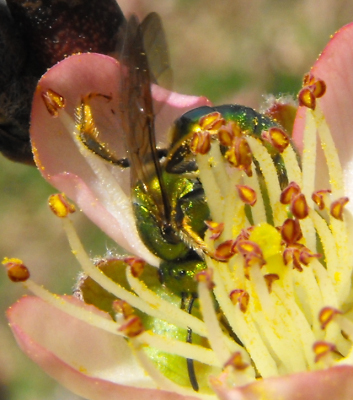
Sweat bees: Halictids
 Halictid
bees, also known as sweat bees, make up a large family of insects with
over 2,000 species. Although some are
drab colored, the common species that visited our peach (Augochlora
pura) was a
brilliant, metallic green, which is typical of many other types of
halictids as well.
Halictid
bees, also known as sweat bees, make up a large family of insects with
over 2,000 species. Although some are
drab colored, the common species that visited our peach (Augochlora
pura) was a
brilliant, metallic green, which is typical of many other types of
halictids as well.
Halictids get their
common name from their tendency to lick salt off
our sweaty skin, making them one of the better known classes of insects
despite their small size. They're also easily startled, and I get
stung by sweat bees more than by any other insect, but the pain
fades
quickly and is a small price to pay for their pollination expertise.
Like bumblebees,
halictids are buzz
pollinators,
which means they're better than honeybees at pollinating blueberries
and tomatoes. They are also generalist pollinators who are glad
to visit any flower full of pollen and
nectar. The combination adds up to a very useful pollinator
species that should definitely be encouraged in your garden.
The best way to build a
healthy population of wild pollinators is
to understand their nesting and foraging requirements and then provide
them with good habitat. Sweat bees nest in bare patches of soil
or in wood, packing brood cells full of pollen and nectar then laying
an egg on top. When the egg hatches out, the larval sweat bee
feeds itself with no help from its parents, then makes its way out of
the nest to live as an adult. Give them a patch of bare ground
and a steady flow of flowers throughout the year and sweat bees will be
industrious pollinators in your garden.
| This post is part of our Native Pollinators lunchtime series.
Read all of the entries: |
Want more in-depth information? Browse through our books.
Or explore more posts by date or by subject.
About us: Anna Hess and Mark Hamilton spent over a decade living self-sufficiently in the mountains of Virginia before moving north to start over from scratch in the foothills of Ohio. They've experimented with permaculture, no-till gardening, trailersteading, home-based microbusinesses and much more, writing about their adventures in both blogs and books.
Want to be notified when new comments are posted on this page? Click on the RSS button after you add a comment to subscribe to the comment feed, or simply check the box beside "email replies to me" while writing your comment.
